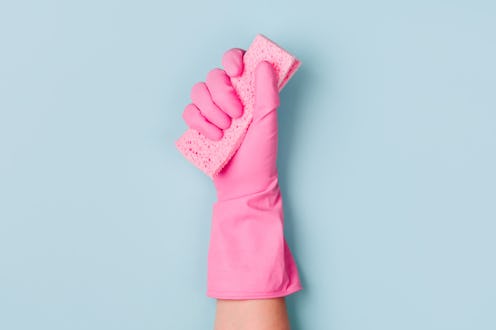(Living)
Don't Skip This Step When Disinfecting With Bleach

You've probably never thought so deeply about cleanliness — and understandably so. However, when it comes to what products to use for proper disinfecting, the information can be a bit confusing. Luckily, the Center for Disease Control and Prevention has laid out specific advice for what to use as well as your best and safest practices. Bleach is one recommended way of killing bacteria and viruses on surfaces, but since it's so potent it's important to know the proper way to use it. And according to expert tips for cleaning with bleach, you may be doing it wrong.
While you're spending so much time in your home, there's no better time to embark upon some serious spring cleaning — not just for your mental wellbeing, but your physical health, too. But first things first: There's a difference between cleaning and disinfecting. The latter is about killing viruses and bacteria, and that's the category bleach falls into (as does alcohol-based sanitizer). Now that that's out of the way, before you begin dousing everything in sight with the stuff, there are certain measures you should take, both for your own safety and to maximize its effectiveness. Ahead, find five tips that will help you clean better with bleach, from medical professionals as well as the CDC.
Tip For Cleaning With Bleach: Protect Yourself
First you'll need to prep a little. Dr. Leann Poston, a physician at Invigor Medical, shares that you'll need to make sure the area you're disinfecting is well-ventilated, so open windows or doors to let potentially harmful fumes disperse. Also, you'l want to protect your skin. "Remember to always wear gloves and then immediately wash your hand with soap and warm water when finished," says Dr. Jay Woody, chief medical officer of Intuitive Health and a co-founder of Legacy ER & Urgent Care. On that note, Dr. Poston adds to be careful of splashing, as bleach solution can irritate skin and eyes (not to mention discolor fabric).
Tip For Cleaning With Bleach: Use Only On Hard Surfaces
According to the experts, bleach is best used on hard, non-porous surfaces. "For soft surfaces, bleach is not a good choice," says Dr. Poston. "Use laundry detergent instead as bleach can discolor fabrics and carpets."
Tip For Cleaning With Bleach: Start With Soap & Water
Dr. Woody — as well as the CDC — recommends first cleaning the area with soap and water, and following up with bleach as a disinfectant. "Cleaners remove dirt and grime," says Dr. Poston. "Soap and water is a great choice. Disinfectants kill viruses and bacteria."
Tip For Cleaning With Bleach: Dilute With (Only) Water
The experts agree: Always dilute your bleach, and only do so using water. "Do not mix bleach with ammonia; it can create chloramine gas which is similar to chlorine gas," says Dr. Poston. "Do not mix bleach with Pine-Sol or vinegar as it will create chlorine gas. Chlorine gas can irritate the eyes and cause breathing problems."
As for the optimum water/bleach solution, it depends on the surfaces you're trying to clean. For food surfaces (non-wood plates, silverware), the CDC recommends 1 tablespoon per gallon of water. For non-food household items (floors, sinks, toys) use 1 cup per 5 gallons,
Tip For Cleaning With Bleach: Allow For Proper Contact Time
"The most important tip for disinfecting is to follow the contact time," says Dr. Woody. "The surface should remain wet on the surface the entire time for the product to be effective. Often, people treat a surface and then immediately dry the surface with a dry towel. When this happens, the disinfectant solution is not effective. You need to leave most disinfecting solutions on surfaces for a period of time and allow the solution to air dry." As for bleach specifically, the recommended contact time is about 10 minutes.
This article was originally published on